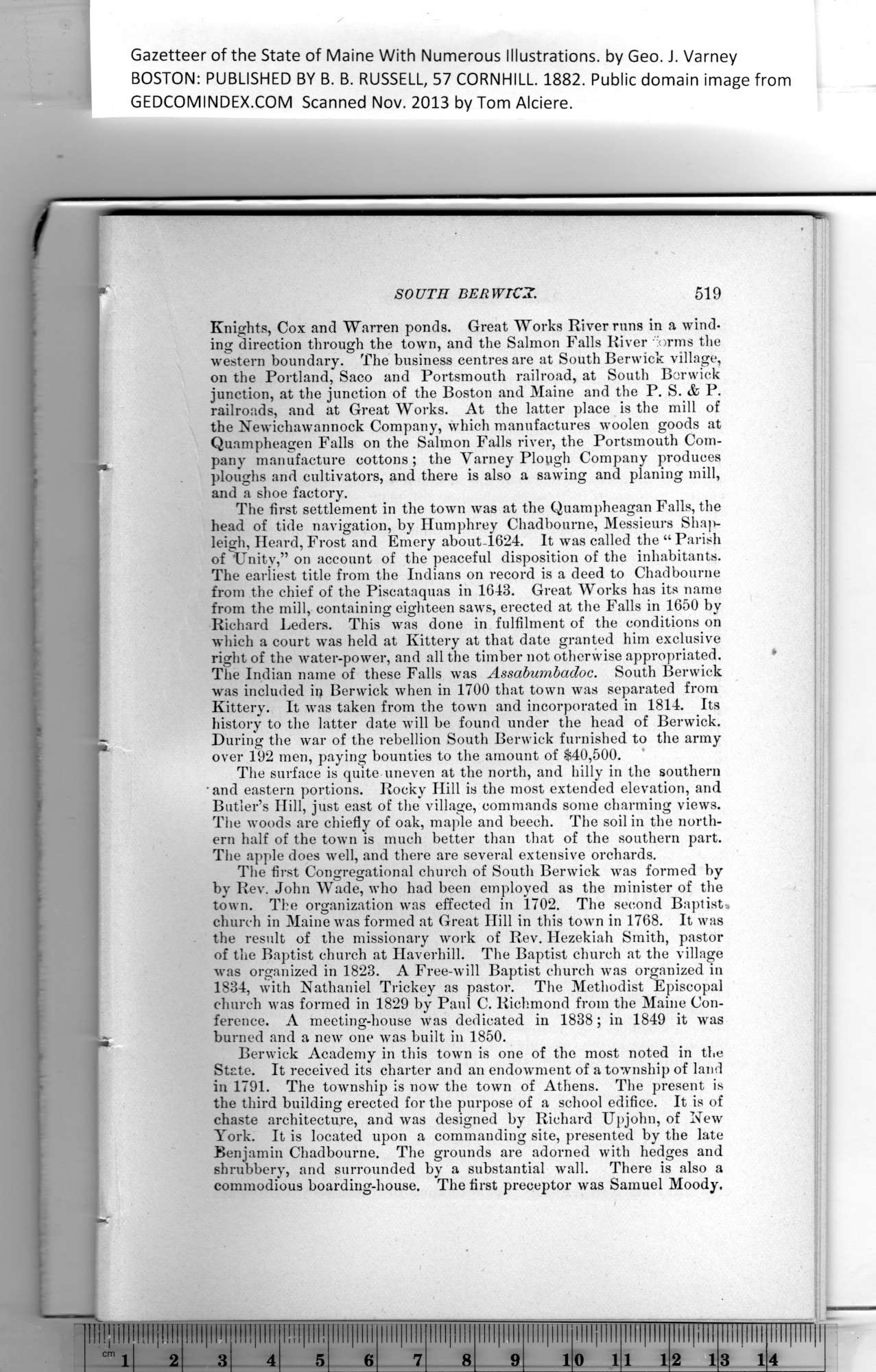|
Gazetteer of the State of Maine With Numerous Illustrations, by Geo. J. Varney
BOSTON: PUBLISHED BY B. B. RUSSELL, 57 CORNHILL. 1882. Public domain image from
SOUTH BERWICK. 519
Knights, Cox and Warren ponds. Great Works River runs in a wind,
ing direction through the town, and the Salmon Falls River 'forms the
western boundary. The business centres are at South Berwick village,
on the Portland, Saco and Portsmouth railroad, at South Berwick
junction, at the junction of the Boston and Maine and the P. S. & P.
railroads, and at Great Works. At the latter place is the mill of
the Newichawannock Company, which manufactures woolen goods at
Quampheagen Falls on the Salmon Falls river, the Portsmouth Com-
pany manufacture cottons; the Varney Plough Company produces
ploughs and cultivators, and there is also a sawing and planing mill,
and a shoe factory.
The first settlement in the town was at the Quampheagan Falls, the
head of tide navigation, by Humphrey Chadbourne, Messieurs Shajv
leigh, Heard,Frost and Emery about-1624. It was called the “Parish
of Unity,” on account of the peaceful disposition of the inhabitants.
The earliest title from the Indians on record is a deed to Chadbourne
from the chief of the Piscataquas in 1643. Great Works has its name
from the mill, containing eighteen saws, erected at the Falls in 1650 by
Richard Leders. This was done in fulfilment of the conditions on
which a court was held at Kittery at that date granted him exclusive
right of the water-power, and all the timber not otherwise appropriated.
The Indian name of these Falls was Assabumbadoc, South Berwick
was included in Berwick when in 1700 that town was separated from
Kittery. It was taken from the town and incorporated in 1814. Its
history to the latter date will be found under the head of Berwick.
During the war of the rebellion South Berwick furnished to the army
over 192 men, paying bounties to the amount of $40,500.
The surface is quite uneven at the north, and hilly in the southern
•and eastern portions. Rocky Hill is the most extended elevation, and
Butler’s Hill, just east of the village, commands some charming views.
The woods are chiefly of oak, maple and beech. The soil in the north-
ern half of the town is much better than that of the southern part.
The apple does well, and there are several extensive orchards.
The first Congregational church of South Berwick was formed by
by Rev. John Wade, who had been employed as the minister of the
town. The organization was effected in 1702. The second Baptist,
church in Maine was formed at Great Hill in this town in 1768. It was
the result of the missionary work of Rev. Hezekiah Smith, pastor
of the Baptist church at Haverhill. The Baptist church at the village
was organized in 1823. A Free-will Baptist church was organized in
1834, with Nathaniel Trickey as pastor. The Methodist Episcopal
church was formed in 1829 by Paul C. Richmond from the Maine Con-
ference. A meeting-house was dedicated in 1838; in 1849 it was
burned and a new one was built in 1850.
Berwick Academy in this town is one of the most noted in the
State. It received its charter and an endowment of a township of land
in 1791. The township is now the town of Athens. The present is
the third building erected for the purpose of a school edifice. It is of
chaste architecture, and was designed by Richard Upjohn, of New
York. It is located upon a commanding site, presented by the late
Benjamin Chadbourne. The grounds are adorned with hedges and
shrubbery, and surrounded by a substantial wall. There is also a
commodious boarding-house. The first preceptor was Samuel Moody,
PREVIOUS PAGE ... NEXT PAGE
This page was written in HTML using a program written in Python 3.2
|
